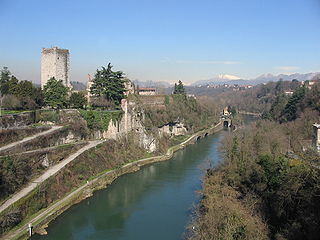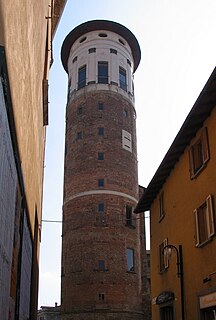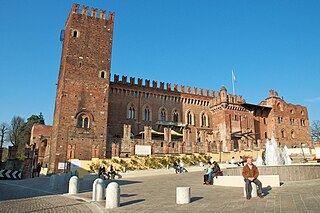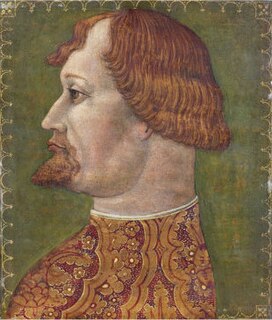
Vigevano is a town and comune in the province of Pavia, Lombardy in northern Italy. A historic art town, it is also renowned for shoemaking and is one of the main centres of Lomellina, a rice-growing agricultural district. Vigevano received the honorary title of city with a decree of Duke Francis II Sforza on 2 February 1532. It is famed for its beautiful Renaissance "Piazza Ducale" in the centre of the town.

Visconti is the family name of important Italian noble dynasties of the Middle Ages. The Visconti of Milan rose to power in their city, where they ruled from 1277 to 1447, initially as Lords then as Dukes and where several collateral branches still exist. The effective founder of the Visconti lordship of Milan was Ottone, who wrested control of the city from the rival Della Torre family in 1277.

Sforza Castle is in Milan, northern Italy. It was built in the 15th century by Francesco Sforza, Duke of Milan, on the remnants of a 14th-century fortification. Later renovated and enlarged, in the 16th and 17th centuries it was one of the largest citadels in Europe. Extensively rebuilt by Luca Beltrami in 1891–1905, it now houses several of the city's museums and art collections.

Cassano d'Adda is a town and comune in the Metropolitan City of Milan, Lombardy, Italy, located on the right side of the Adda River. It is on the border of the Metropolitan City of Milan and the province of Bergamo. It is served by Cassano d'Adda railway station.

Trezzo sull'Adda is a comune (municipality) in the Metropolitan City of Milan in the Italian region Lombardy, located about 30 kilometres (19 mi) northeast of Milan on the Adda River.

The Trezzo sull'Adda Bridge or Trezzo Bridge was a medieval bridge at Trezzo sull'Adda in Lombardy, Italy, spanning the Adda river. Completed in 1377, the single-arch bridge held the record for the largest span for over four hundred years, until the beginnings of the Industrial Age, while it was not until the early 20th century that masonry bridges with larger openings were constructed.

San Giovanni in Conca is a crypt of a former basilica church in Milan, northern Italy. It is now located in the centre of Piazza Missori.

Soncino Castle is a military fortress in Soncino, northern Italy. It was built in the 10th century, and it was active since the years around 1500.
The Sala delle Asse, is the location for a wall and ceiling painting in tempera on plaster, of decorated "intertwining plants with fruits and monochromes of roots and rocks", by Leonardo da Vinci, dating from about 1498 and located in the Castello Sforzesco in Milan.

The Visconti Castle of Somma Lombardo is a medieval castle-palace in Somma Lombardo, Province of Varese, Region of Lombardy, Italy.

The Castello Visconteo di Pagazzano is a moated, late-medieval castle located in Pagazzano, a town in the Province of Bergamo in the Italian region of Lombardy.

The Palazzo Prinetti is a palace located in the town of Merate, in the Province of Lecco, in the Region of Lombardy, Italy.

The Castello di Bereguardo is a medieval castle located on Via Castello 2 in the town of Bereguardo, Province of Pavia, region of Lombardy, Italy.

The Castello di Carimate is a 14th-century castle located on Piazza Castello #1 in the town of Carimate, Province of Como, Lombardy, Italy.

The Castle of Trezzo sull'Adda is a castle located on a hill within a bend of the Adda river and from this protected on two sides. On the remaining side it is closed by a wall and a 42-meter high tower. Part of the castle was the fortified bridge over the river, destroyed in 1416.

The Visconti Castle or Castello Visconteo is a castle located in Cusago near Milan. It was built in the 14th century by Bernabò Visconti and used as a hunting lodge by the Visconti family, lords and dukes of Milan. The castle underwent significant changes in the Renaissance period. Today it is in a state of abandonment.

The Visconti Castle of Abbiategrasso is a Middle Age castle located in Abbiategrasso, Metropolitan City of Milan, Lombardy, northern Italy. It lies on the axis of the Naviglio Grande and from its tower the navigation along the canal toward Milan could be controlled. In the 15th century it was one of the preferred places of residence of the dukes and duchesses of Milan.

The Visconti Castle of Binasco is a Middle Age castle located in the center of Binasco, Metropolitan City of Milan, Lombardy, northern Italy. It is famed for having been the prison of Beatrice di Tenda, who was arrested and there sentenced to death for adultery in 1418. Today it is the seat of the municipality of Binasco.


































